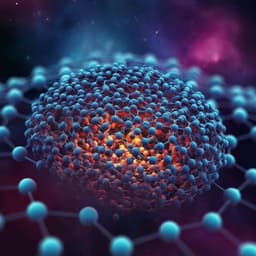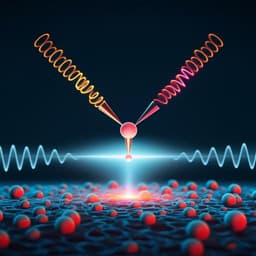
Chemistry
Can electric fields drive chemistry for an aqueous microdroplet?
H. Hao, I. Leven, et al.
Discover how aqueous microdroplets can dramatically accelerate organic reaction rates, increasing them by up to six orders of magnitude! This fascinating research by Hongxia Hao, Itai Leven, and Teresa Head-Gordon explores the electric field dynamics at the air-water interface, revealing why surface reactivity is so significantly enhanced. Dive into the underlying physics of this breakthrough!
Playback language: English
Introduction
The study of chemical reactions in aqueous microdroplets has revealed a significant phenomenon: reaction rates are dramatically accelerated compared to bulk solutions, often by one to six orders of magnitude. This observation has sparked considerable interest, as understanding the underlying mechanisms could lead to new strategies for chemical synthesis and catalysis. However, the reasons behind this rate enhancement remain elusive, prompting this research to investigate the role of electric fields at the air-water interface.
The research question centers on identifying the primary cause of the observed reaction rate acceleration in aqueous microdroplets. The hypothesis is that the enhanced reactivity stems from the unique electric field distributions present at the air-water interface. The purpose of this study is to computationally characterize these electric field distributions and to explore their potential impact on chemical bond weakening and breaking. This is crucial because understanding this phenomenon holds implications for various applications involving microdroplets, such as electrospray ionization mass spectrometry, synthesis of novel materials, and biological processes.
The significance of this research stems from its potential to unravel a fundamental aspect of chemistry at interfaces. A comprehensive understanding of reaction kinetics in microdroplets could lead to the design of novel microfluidic reactors for efficient and selective chemical transformations. It may also shed light on the role of interfacial electric fields in other areas of chemistry and biology, where reaction rates are influenced by surface phenomena.
Literature Review
Prior research has extensively documented the accelerated reaction kinetics in microdroplets. Studies by Yan, Bain, and Cooks (2016) and Wei et al. (2020) have reviewed the considerable rate enhancements observed in a wide variety of organic reactions. These studies established a clear trend but didn't fully explain the underlying causes. Other work, like Banerjee and Zare (2015) and Nam et al. (2018), demonstrated accelerated reaction rates in specific synthetic applications, including the synthesis of isoquinoline, quinolines, and ribonucleosides. However, these studies mostly focused on experimental observations without a detailed mechanistic understanding of the phenomena. Furthermore, some studies (e.g., Pestana et al., 2020; Gallo et al., 2019; Wilson et al., 2020) have begun to examine the role of water's microsolvation environment and the kinetics at the interface but still lack a unified theoretical explanation. A significant challenge has been reconciling experimental measurements of surface potential and electric fields with theoretical calculations, with discrepancies between ab initio methods and classical force fields highlighted by Leung (2010), Kathmann et al. (2011), and Cendagorta and Ichiye (2015). This discrepancy underscores the need for more sophisticated theoretical approaches that can accurately capture the complex interplay of structural and electronic factors at the interface.
Methodology
The researchers employed a coarse-grained electron model (C-GeM) integrated with the ReaxFF reactive force field to investigate electric field distributions in aqueous microdroplets. This approach avoids the computational expense of ab initio methods while still capturing essential features of the system's electronic structure. The model incorporates both the structural organization and electron densities of the water molecules, allowing for the calculation of electric fields at the air-water interface.
The methodology involved several key steps: (1) System Preparation: Water droplets of varying sizes (radii of 40 Å, 60 Å, and 80 Å) were generated using PACKMOL, with and without added ions (H3O+, OH−, Na+, Cl−) to explore the influence of ionic strength. (2) Molecular Dynamics Simulations: AMOEBA force field within the Tinker-OpenMM platform was used for system minimization and equilibration. Subsequently, simulations were conducted using the ReaxFF/CGeM model in LAMMPS, collecting snapshots to calculate electric fields. (3) Electric Field Calculations: Electric fields were calculated on a grid, with particular attention paid to the normal and parallel components relative to the air-water interface. The surface potential was calculated using a summation of Gaussian densities. (4) Electric Field Projection: Electric fields were projected onto the O-H bonds of surface water molecules to assess the effect on bond stability. This involved averaging the electric field over grid points within a specified distance of the O-H bond, excluding points too close to the molecule to avoid intramolecular interactions. (5) IRPD Calculations: Infrared Photodissociation (IRPD) spectroscopy data was utilized for comparison and validation of ReaxFF/C-GeM model predictions. (6) Ion Concentration Determination: Ion concentrations were determined based on the Rayleigh limit, which describes the maximum number of charges that can stably reside on a droplet's surface. The Rayleigh instability is governed by the balance between electrostatic repulsion and surface tension (Equation 2 in the paper). (7) Charge Density Profile Determination: The instantaneous surface method was employed to define the interface and the regions where the charge density changes with distance were identified. A cumulative charge density was calculated by averaging the Gaussian densities to the core/shell centers, starting from the air-water interface toward the droplet center. The accumulated charge density is calculated every 0.2 Å in the distance scan.
The calculations used different methods to evaluate the electric fields: direct grid calculation, derivative of the surface potential, and projection onto O-H bonds. Different sizes and ion concentrations for water droplets allowed for a comprehensive analysis of electric field behavior under various conditions.
Key Findings
The key findings of this research demonstrate a significant enhancement of electric fields at the air-water interface of aqueous microdroplets compared to the bulk. The study found that the average electric field strength along free O-H bonds at the surface is approximately 16 MV/cm larger than those in the droplet's interior. This substantial difference in electric field strength suggests that interfacial electric fields might be the major driver of the experimentally observed rate enhancements in microdroplets.
Further analysis revealed that the electric field distributions at the surface exhibit significant heterogeneity, with local field strengths reaching magnitudes an order of magnitude higher than the average. This heterogeneity arises from the nonlinear coupling of intramolecular polarization with intermolecular solvent modes. These fluctuations, the authors argue, greatly increase the likelihood of chemical bond weakening or breaking relative to bulk water.
The research also explored the influence of ions on the electric field distributions. While the presence of excess H3O+ or OH- ions causes only minor changes in the average electric field, the local fields near the ions can be considerably stronger. This suggests that local electrostatic interactions can further enhance reactivity near ions.
The researchers projected the calculated electric fields onto the O-H bonds at the surface and in the interior of the water droplet. The average projected electric field is ~16 MV/cm larger on the surface free O-H bond compared to the internal bonds. This suggests that the surface free O-H bonds are substantially destabilized.
Using a simple bond dipole-field model, the researchers estimated that the 16 MV/cm difference in electric field strength between surface and bulk water can lower the activation energy barrier for a water bond dissociation by about 2.1 kcal/mol. This translates to a rate enhancement of 1-2 orders of magnitude. The significant broadening of the electric field distribution for surface bonds further increases the probability of chemical bond weakening or breaking, potentially contributing significantly to the overall acceleration of chemical reactions. This finding demonstrates the importance of considering local electric field fluctuations in explaining the enhanced reactivity of microdroplets.
Discussion
This study successfully demonstrates the crucial role of electric fields at the air-water interface in driving the enhanced reactivity observed in aqueous microdroplets. The significantly higher electric field strengths and their heterogeneity at the surface, compared to the bulk, provide a compelling explanation for the observed rate accelerations. The findings resolve the long-standing discrepancy between experimental measurements and theoretical calculations of interfacial electric fields by emphasizing the importance of both the structural arrangement of water molecules and the electronic response at the interface. The study's computational approach, using the ReaxFF/C-GeM model, effectively captures the necessary details of electronic structure and electrostatic interactions, thereby providing accurate estimates of electric fields and their influence on reactivity. The consistency of the results obtained from direct electric field calculations and the surface potential derivative, especially when compared to the AIMD calculations, validates the methodology and provides robust support to the findings. The 1-2 orders of magnitude rate enhancement estimated from the simple model, along with the observed significant heterogeneity of local field strengths, suggests that even larger rate accelerations may be possible under certain conditions.
The research also highlights the limitations of previous theoretical models, which often failed to accurately represent both the inner mean potential and the fluctuating nature of electric fields at the interface. The broader implications of this work extend beyond microdroplets, suggesting that similar interfacial electric field effects may play a role in other heterogeneous catalytic systems, including enzyme catalysis. Future research should focus on extending this approach to a wider range of reactions, examining the impact of different solvents, and investigating the interplay between electric fields and other factors, such as specific ion effects.
Conclusion
This work provides compelling evidence for the importance of surface electric fields in driving the enhanced chemical reactivity observed in aqueous microdroplets. The study's findings, based on a detailed computational analysis using the ReaxFF/C-GeM model, clearly demonstrate the significant magnitude and heterogeneity of electric fields at the air-water interface. This contributes to resolving discrepancies between previous experimental and theoretical studies. Future studies should apply this methodology to investigate the broader range of organic reactions where microdroplet acceleration is observed, focusing on the precise correlations between electric field distributions and observed rate enhancements to further refine our understanding of interfacial chemistry.
Limitations
While the ReaxFF/C-GeM model offers a computationally efficient way to study the electric field distributions in water droplets, it is still an approximation. The accuracy of the model's predictions depends on the quality of the underlying force field and the extent to which it captures the complexities of electronic structure and electrostatic interactions. The analysis focused primarily on water droplets with specific sizes and ion concentrations, limiting the generalizability of the findings to other droplet sizes and ionic conditions. The simple bond dipole-field model used to estimate the free energy lowering is also an approximation, neglecting other potential factors that might contribute to the observed rate enhancements. Further studies are needed to validate the findings using experimental measurements of electric fields at the surface of microdroplets and to develop more refined models that account for additional factors such as solvent dynamics and specific reactant interactions. The electrospray process itself was not modeled directly, and the effective concentration of ions may therefore need to be reconsidered.
Related Publications
Explore these studies to deepen your understanding of the subject.







